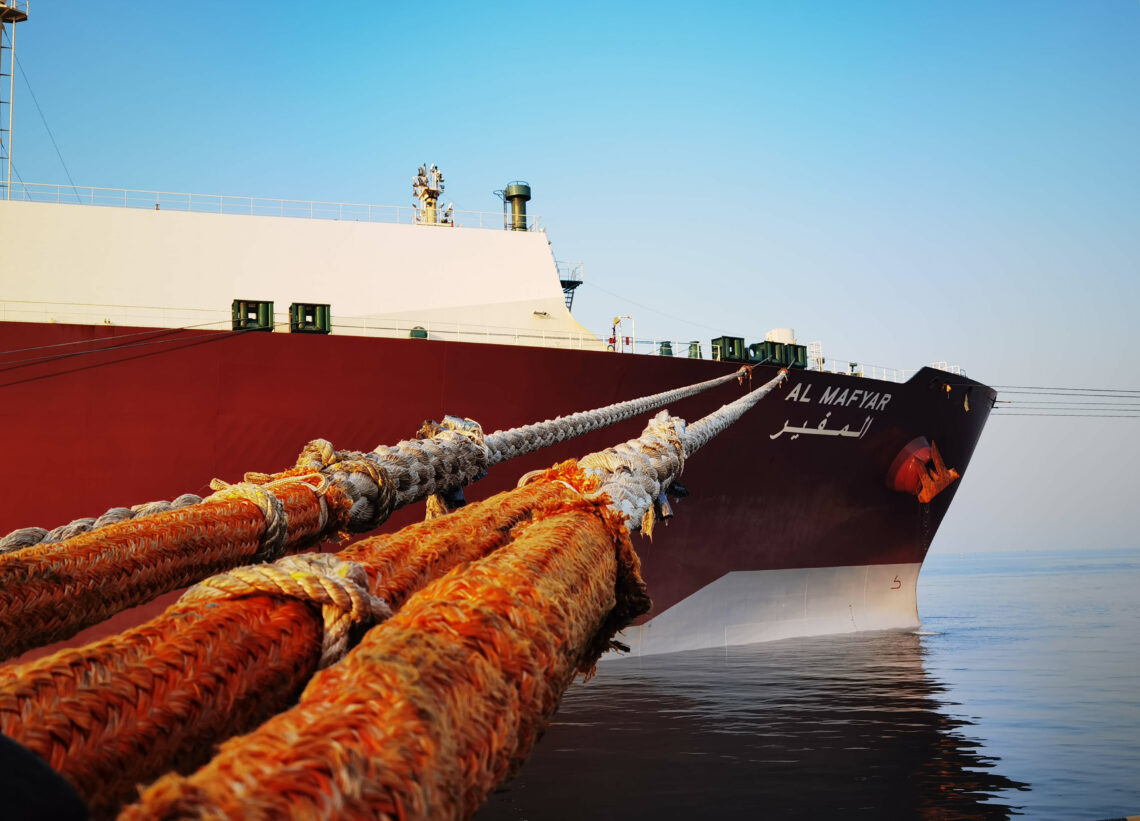Regulatory disparity and the geopolitics of shipping
Environmental protection schemes are putting the international shipping industry under pressure to reduce carbon emissions. To avoid a regulatory collision with the International Maritime Organization, shipping conglomerates are investing in alternative fuels.

In a nutshell
- Shipping faces patchwork environmental regulations
- The industry will turn toward new fuels as a transition measure
- Asia’s LNG infrastructure will be advantageous for China
Shipping carries around 90 percent of global trade in goods and therefore accounts for an enormous share of the world’s greenhouse gas emissions. According to studies conducted by the International Maritime Organization (IMO), an agency of the United Nations, ships worldwide emit more than 1 billion tons of CO2 annually, about as much as some of the world’s largest industrialized countries. Carbon pollution is expected to increase by up to 50 percent by 2050 if no legislative action is taken, which puts the industry under intense scrutiny.
Regulation changes
Global shipping has recently been subject to political shifts. For decades, shippers have enjoyed a flexible regulatory framework, as neither the 1992 United Nations Framework Convention on Climate Change (UNFCCC) nor the 1997 Kyoto Protocol applied to the industry. Instead, the Kyoto Protocol delegated all the work on reducing shipping emissions to the IMO. In recent years, the organization has adopted rules to collect data on emissions and has established strategies to reduce them by 2050. However, the slow pace of these efforts, partly due to concerns about international trade and the impact on supply chains, has angered decision makers worldwide. The European Union in particular would like to see international shipping subject to stricter environmental regulations – a stiff challenge due to the conflicting priorities of the 174 IMO member nations.
The EU’s open clash with the IMO will likely affect the industry’s competitiveness.
In September 2020, the European Parliament voted overwhelmingly to extend the EU emissions trading system (ETS) to international shipping. Subsequently, during the Marine Environment Protection Committee session held in November 2020, the IMO approved energy efficiency and carbon intensity target amendments to the International Convention for the Prevention of Pollution from Ships (MARPOL). The hope was to keep environmental regulations at a global level. Yet the amendments have received stern criticism from advocates for regional rules. Critics argue that, by allowing emissions to grow until 2030, the changes fall short of any real ambition to tackle climate issues.
Facts & figures
Carbon leakage
Under the EU emissions trading system (ETS), carbon leakage refers to businesses transferring their production to countries with less stringent emissions constraints. For example, a company could choose to relocate from one country with high carbon taxes to another where such costs would be lower.
Market distortions
The EU’s open clash with the IMO will likely affect the industry’s competitiveness. The inclusion of shipping under the bloc’s ETS scheme will pose several challenges to both seafaring companies and countries. In 2012, the EU unilaterally attempted to include another transport mode, aviation, in the ETS. As a result, 23 countries including China, the United States and Russia, signed the Moscow Joint Declaration, which urged European states to work within the International Civil Aviation Organization on a multilateral approach to address emissions rather than create regional regulations. Following significant international political pressure, the ETS’s scope was narrowed to only EU aviation. In the short term, the maritime stakeholders that are particularly dependent on heavy fuel oil and marine gas oil will likewise continue to object to regional rules and the ETS scheme.
Despite the EU’s questionable approach from the perspective of international law, shipping is likely to be included in the ETS. There is worldwide momentum to meet the aims of the Paris Agreement and growing dissatisfaction with how the IMO is handling the sector’s environmental impact. Shipping remains the only sector in the EU with no specific commitments to reduce greenhouse gas emissions, which contravenes the European Green Deal.
In October 2020, the head of China’s climate change office revealed a national emissions trading scheme for 2021 to 2025. The plan will include all major industrial sectors and thus probably shipping, possibly mirroring the EU’s extraterritorial setup. Other countries could follow suit, creating a difficult network of mismatched policies. Patchwork rules would likely have shippers pay twice for the same amount of emissions, a cost which would then be passed on to consumers in the form of an additional carbon tax.

Legislators could also limit the scope of such schemes to regional shipping companies. However, this would distort the level playing field, since the targeted shippers would lose some of their market share to others who operate under less stringent climate rules. The situation could lead to carbon leakage and further political tension between regions.
Representatives of the industry will probably try to stem the tide by advocating measures that promote sustainability while still allowing their members to remain competitive. In December 2019, BIMCO, Cruise Lines International Association, INTERCARGO, INTERFERRY, International Chamber of Shipping, INTERTANKO, International Parcel Tankers Association and the World Shipping Council, agreed to establish an NGO that will develop and promote a collaborative industry-funded program for shipping emissions research and development. The organization could serve as a policy tool to counter incohesive interventions when the IMO, which may be hampered by the conflicting interests of its members. The initiative will likely gain further support as more patchwork regulations emerge.
Shift to Liquefied Natural Gas
The industry-led program will look into fuel, battery and propulsion systems to get nearer to the Paris Agreement targets. However, these technologies have yet to be developed at the scale necessary for widespread long-distance shipping. For now, one of the fastest and greenest ways to avoid regulatory disparity is by using different fuels. While Danish container giant Maersk is investigating various zero-emission renewable solutions, liquefied natural gas (LNG) is emerging as a strong candidate for others that are exploring and investing in it. Among world conglomerates, German container liner Hapag-Lloyd and French carrier CMA CGM are converting their existing fleet to LNG and purchasing new LNG-powered vessels.
Shipping will increasingly be drawn into geopolitical tensions.
Numerous countries are racing to adapt their ports so that LNG can be stored in the terminals. In November 2020, Spanish electric utility company Endesa revealed that it will invest up to 34.5 million euros to build Spain’s largest LNG bunkering terminal. In Singapore, the world’s largest bunker port revealed plans to substantially increase its capacity to supply LNG for ships soon. Italy and South Africa will complete the construction of new LNG bunkering stations in 2021, and numerous new Brazilian terminals will be operational as of 2022. The International Association of Ports and Harbors has recently issued guidelines for the safe handling of LNG ships, underlining the likelihood of a substantial increase in maritime LNG infrastructure and vessels in the coming period.
LNG market players
With natural gas as the likely market choice as a bridge between oil and new technologies, shipping will increasingly be drawn into the geopolitical tensions and opportunities that surround the LNG market.
While Europe, South Africa and South America are modernizing their infrastructure for import and storage, their efforts pale in comparison with Asia, which has been establishing vast LNG import and export terminals. Asia is expected to account for 56 percent of global LNG import terminal capacity growth by 2023, through China’s Belt and Road Initiative, among others. Shipping will therefore rely substantially on Asian and Chinese LNG infrastructure and connectivity during the fuel transition.
China’s strategy is to diversify and seek out multiple exporters while avoiding long-term commitments.
For now, China is relying on Qatar and Australia to provide LNG, but the global power will likely also look toward other market players, like Russia and the U.S., to satisfy the growing demand.
Outlook
In recent years, the U.S. has emerged as the fastest-growing producer of LNG, yet its exports to China have been stifled by the trade conflict. With the Biden administration incoming, Beijing has recently shown interest in reigniting trade by signing a deal to buy liquefied natural gas from an American exporter for the first time since the beginning of the dispute.
China’s strategy is to diversify and seek out multiple exporters while avoiding long-term commitments. Russian company Gazprom, one of the largest producers of LNG, disclosed that it had entered negotiations with China’s National Petroleum Corp. to increase deliveries of pipeline LNG. The deal would boost Russia’s market share at a time when the country is at a competitive disadvantage because new LNG supply from the U.S. has created a glut. Should the negotiations prove fruitful, China will likely look into additional pipeline deals with Russia, building up energy security with multiple international suppliers and safeguarding itself from potential disruptions like further trade disputes.
By strategically developing its shipping and LNG infrastructure, China is securing its importance as a global maritime player, which will influence Beijing’s foreign policy in the coming years.



